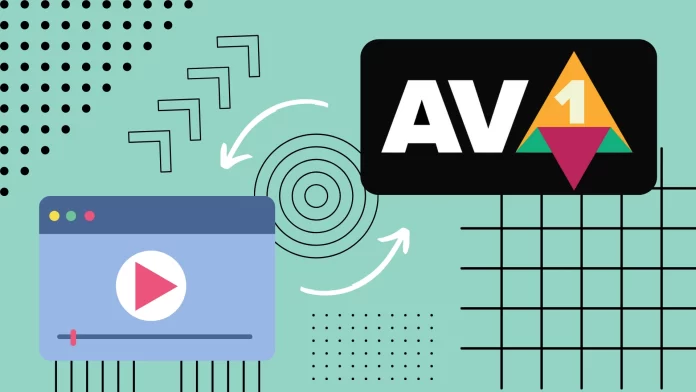The AV1 codec represents a significant leap forward in video compression technology, designed to address the escalating demand for efficient video delivery in today’s digital world. At its core, AV1 is a video codec, a software or hardware-based solution that compresses and decompresses digital video content. Its primary purpose is to reduce the file size of videos while maintaining visual quality, enabling smoother transmission and playback across various platforms.
Let’s take a closer look at all its advantages and disadvantages below.
What is the AV1 codec?
The AV1 codec, also known as AOMedia Video 1, is a technology used to compress videos so they can be easily transmitted and viewed over the internet. AV1 is one of the most advanced and efficient video codecs developed by a group of big tech companies, including Google, Microsoft, Amazon, and Netflix, who formed the Alliance for Open Media (AOMedia).
AV1 works by using smart techniques to reduce the size of video files, making them smaller while maintaining good visual quality. This is important because it allows videos to load quickly and play smoothly on websites and streaming platforms like YouTube and Netflix, even if your internet connection is not super fast.

One fantastic thing about AV1 is that it’s free for everyone to use. This means that content creators, websites, and streaming services don’t have to pay any special fees or licenses to use AV1 technology. It also helps make high-quality video streaming more accessible to people all over the world, regardless of their internet speed or data limits.
The AV1 codec is a powerful tool that makes videos smaller while keeping them looking great. Tech companies widely support it and make video streaming faster and more efficient, making it a game-changer for online video content.
Why do you need an AV1 codec?
AV1 is a codec that allows you to compress a huge amount of data without reducing video quality. This means that it can be a big advantage for future high frame rate video formats, 8K resolution, HDR standards, and audio requirements.
This means that the most tangible advantage of this codec is for streaming services such as Netflix, Disney Plus, or Hulu.
In addition to the AV1 codec being a universal compression standard, this allows it to be used for many other apps, such as video games, real-time apps such as video conferencing, or any other programs where video streams are used.
AV1 is planned to be the successor to the HEVC (H.265) format, which is currently used for 4K HDR video. This format can currently be found on platforms such as Prime Video, Apple TV+, Disney Plus, and Netflix.
AV1 was developed by the Alliance for Open Media, which counts Amazon, Apple, ARM, Facebook, Google, Intel, Microsoft, Mozilla, Netflix, Nvidia, and Samsung.
What are the main advantages of the AV1 codec?
The AV1 codec offers several key advantages that make it a compelling choice for video compression and streaming:
- Improved Compression Efficiency: One of the main advantages of AV1 is its superior compression efficiency. It can significantly reduce the size of video files without sacrificing visual quality. This means that high-quality videos can be streamed and delivered over the internet with lower bitrates, saving bandwidth and reducing data usage for both content providers and viewers.
- Royalty-Free and Open Source: AV1 is an open-source codec, which means it is free to use and doesn’t require licensing fees or royalties. This makes it an attractive choice for content creators, streaming platforms, and hardware manufacturers as they can adopt AV1 without any legal or financial restrictions, fostering widespread adoption and innovation.
- Broad Industry Support: AV1 is supported by a wide range of major tech companies, including Google, Microsoft, Amazon, Netflix, and others, who are part of the Alliance for Open Media (AOMedia). This broad industry support has led to increased implementation of AV1 across various platforms, including web browsers, operating systems, and hardware devices.
- Future-Proof Technology: As an open-source codec, AV1 is continuously evolving and can adapt to emerging video standards and technologies. This ensures that it remains relevant and efficient in the face of changing video streaming requirements and advancements in hardware capabilities.
- Reduced Bandwidth Requirements: AV1’s efficient compression means that video streaming platforms can deliver high-quality content with reduced bandwidth requirements. This is especially beneficial in areas with limited internet connectivity, as it allows users to access high-quality video content without experiencing buffering or playback issues.
- Competition with Established Codecs: AV1 competes directly with established video codecs like H.264 and H.265, offering a compelling alternative for content delivery. Its ability to outperform these codecs in terms of compression efficiency and visual quality makes it a promising contender for the future of video streaming.
In conclusion, the AV1 codec’s main advantages lie in its improved compression efficiency, high visual quality, royalty-free, and open-source nature, broad industry support, and future-proof technology. These features make AV1 a game-changer in the world of video compression, paving the way for a more efficient and accessible video streaming experience for users and content providers alike.
What disadvantages does the AV1 codec have?
While the AV1 codec offers numerous advantages, it also comes with some disadvantages and challenges:
- High Processing Power Requirements: AV1’s advanced compression techniques demand significant processing power for both encoding and decoding video content. This can pose challenges for devices with limited hardware capabilities, potentially leading to increased power consumption and reduced battery life.
- Limited Hardware Support: Despite growing adoption, not all devices and hardware natively support AV1 decoding. Older devices or platforms without AV1 support may struggle to handle AV1-encoded content efficiently, requiring software updates or alternative codec fallbacks.
- Slow Encoding Times: AV1’s complexity can lead to slower video encoding times compared to other codecs. This can be a concern for content creators and video streaming platforms, as longer encoding times could impact content production workflows and delivery schedules.
- Patent and Licensing Uncertainties: While AV1 is intended to be royalty-free, open-source, and free to use, the landscape of video codecs and associated patents can be complex. There may be concerns and legal challenges regarding potential patent infringement in the future, which could impact its adoption and usage.
- Limited Adoption on Older Browsers: AV1 adoption is growing, but older web browsers may not support it. This can create compatibility issues for users with outdated browser versions, potentially requiring manual codec selection or fallback mechanisms.
These disadvantages may require careful consideration and adaptation when adopting AV1 for video compression and streaming purposes. However, the continuous development and broad industry support for AV1 indicate ongoing efforts to address these challenges and enhance the codec’s overall performance and accessibility.
What devices or programs support AV1 codec
Here are some examples of devices and programs that support AV1:
Web browsers
- Google Chrome has included AV1 support for HTML5 video playback on desktop and mobile versions.
- Mozilla Firefox: Firefox supports AV1 for HTML5 video playback on desktop and mobile platforms.
- Microsoft Edge: Edge supports AV1 for HTML5 video playback on Windows and macOS.
Video streaming platforms
- YouTube: YouTube has been one of the early adopters of AV1, offering AV1-encoded videos for specific resolutions and devices to improve streaming efficiency.
- Netflix: Netflix has also begun using AV1 to deliver video content, enhancing the streaming experience for supported devices and resolutions.
Media Players
- VLC Media Player: VLC has integrated AV1 support, allowing users to play AV1-encoded videos on their desktop or mobile devices.
- FFmpeg: FFmpeg, a popular multimedia framework, added support for AV1, enabling content creators and developers to work with AV1-encoded content.
Hardware Support
- Some newer generation smartphones, tablets, and smart TVs have started incorporating hardware decoding support for AV1, providing smoother video playback and lower power consumption for AV1-encoded content—almost all devices produced after late 2021 support AV1.
Operating Systems
- Android: Android devices have been gradually adopting AV1 support for both web browsers and video playback.
- Windows 10: With the inclusion of AV1 in Microsoft Edge and support for AV1 in Windows Media Player, Windows 10 has enabled AV1 playback on compatible devices.
Keep in mind that AV1 support may vary depending on the device’s hardware capabilities, software versions, and the availability of software updates. Additionally, with the continuous development of AV1 and its increasing industry support, more devices and programs are likely to adopt AV1 in the future.
For the most up-to-date information on AV1 support, I recommend checking official announcements and documentation from the manufacturers and software developers of the devices and programs you are interested in.





